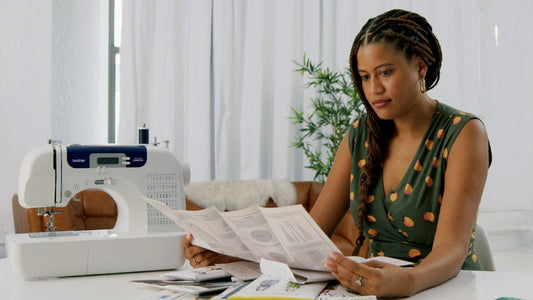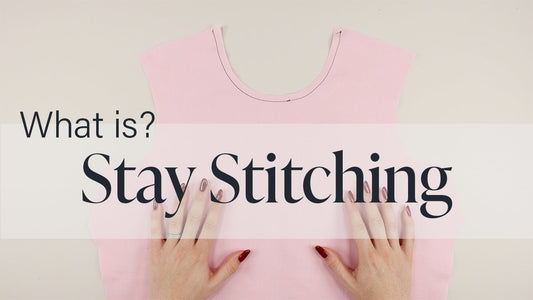I still remember sitting down at my sewing machine for the first time—scissors that barely cut, pins everywhere, fabric sliding off the table. It was messy, frustrating, and I almost gave up.
But little by little, I realised that having the suitable sewing tools makes the sewing process easier. Maybe It’s not fancy or expensive tool—it’s about tools that help you feel in control, keep things tidy, and give you results you’re proud of. If you’re looking for reliable sewing tools for beginners, these are the 10 I’d recommend to anyone just starting out.
Let’s dive in—and I’ll share why each tool earned a permanent spot in my sewing corner with Sewpronto.

1. Rotary Cutter
Honestly, I didn’t buy a rotary cutter right away. I thought scissors were enough—until I tried cutting long strips of fabric and ended up with jagged, uneven lines. The first time I sliced through a full yard with a rotary cutter, it felt like magic.
What I love about it: it’s fast, super clean, and doesn’t shift the fabric as you cut. If you’re doing quilting, bias tape, or working with knits, it’s a total game changer.
2. Self-Healing Cutting Mat
At first, I used an old table and hoped for the best. But once I got a proper cutting mat, everything felt more legit. The gridlines helped me measure faster, and I wasn’t worried about damaging my surface anymore.
Mine lives under my machine and doubles as a base for trimming patterns. If you’re getting a rotary cutter, this is a must.
3. Acrylic Quilting Ruler
When I started quilting, I was eyeballing cuts and wondering why nothing lined up. A friend handed me her clear quilting ruler, and it was like putting on glasses—suddenly everything made sense.
It’s transparent, has inch marks, angles, and lets you cut perfectly straight with your rotary cutter. I now have three of them, in different lengths!
4. Glass Head Pins
I used cheap plastic pins for a while—until I melted them with my iron. Lesson learned. Glass head pins won’t melt, they slide into fabric easily, and they don’t leave big holes.
Now I always keep a set near my machine. And when I’m pressing seams with pins still in place, I don’t have to worry about a mess.
5. Magnetic Pin Holder
True story: I knocked over my pin cushion three times in one day. Then I got a magnetic pin holder. Problem solved.
It’s fast, easy, and even fun to use. When pins fall, just wave the magnet over them and they jump back. Mine was $6 and worth every cent.
6. Seam Ripper
I used to hate using this because it felt like admitting I messed up. But now I think of it as a little eraser—it gives me permission to fix things without stress.
A sharp seam ripper removes stitches cleanly, and once you get the hang of it, you’ll even use it on purpose to tweak fit or open buttonholes. I keep one by my machine, and another in my travel kit.
7. Fabric-Only Scissors
Yes, you need a dedicated pair of scissors just for fabric. I learned this the hard way after someone used mine on paper—ruined them.
Good fabric scissors make smooth, confident cuts. You’ll get cleaner seams and neater finishes, which makes sewing so much more satisfying.
8. Thread Snips
These are like little scissors that live next to my machine. I use them for trimming threads after every seam, snipping into corners, or cleaning up hems.
They’re lightweight, precise, and a lot safer than trying to angle big scissors into tiny spaces.
9. Marking Tools
I used to skip this step and just “guess” where to fold or sew. But once I started marking darts, pleats, and notches properly, my garments came together so much better.
My go-to tools are water-soluble pens and heat-erase markers. They show up when I need them, and disappear when I press or rinse.
Just remember to test on scrap first.
10. Pressing Tools
This one surprised me the most. I thought ironing was just for the end of a project, but pressing as you sew makes your work cleaner and easier to manage.
I even made my own mini pressing board out of wood, batting, and a cotton cover. It sits next to my machine so I don’t have to run back and forth for every seam.
Conclusion
The biggest improvement in my sewing didn’t come from learning a fancy technique—it came from using better tools. These sewing tools in sewing aren’t just convenient; they gave me more confidence and made sewing feel fun instead of frustrating.
If you're collecting your first set of sewing tools for beginners, start with the basics. Add what you need as you go. Trust me, even one or two of these will make your next project smoother and way more enjoyable.
Want a printable checklist or my favorite starter-kit recommendations? Let me know—I'd love to share what worked for me.




